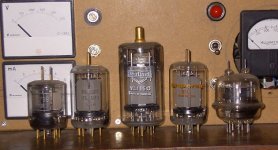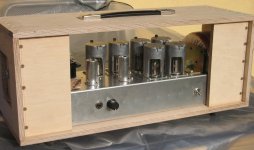My brother suggested I join this forum about very technical tube stuff. I'm new to this forum. I never heard of anyone talk much on EL156 since it's quite popular in Japanese DIY Audio field.
I read its specification, it can run 450V for class A and class AB up to 800V.
It's a pentode, but can be run in triode for 500V. I see someone claimed a pair of these in PP capable for 150W!
Therefore, which way you prefer class A pentode or triode, or high power in class AB with much high operating voltage??
I read its specification, it can run 450V for class A and class AB up to 800V.
It's a pentode, but can be run in triode for 500V. I see someone claimed a pair of these in PP capable for 150W!
Therefore, which way you prefer class A pentode or triode, or high power in class AB with much high operating voltage??
My brother suggested I join this forum about very technical tube stuff. I'm new to this forum. I never heard of anyone talk much on EL156 since it's quite popular in Japanese DIY Audio field.
I read its specification, it can run 450V for class A and class AB up to 800V.
It's a pentode, but can be run in triode for 500V. I see someone claimed a pair of these in PP capable for 150W!
Therefore, which way you prefer class A pentode or triode, or high power in class AB with much high operating voltage??
Hi ,
a pair EL156 can deliver 130W rms with 800V plate and 400V at the screens. Look at the spec sheet:
http://frank.pocnet.net/sheets/128/e/EL156.pdf
73
Wolfgang
I'd be very cautious with these Chinese firecrackers which are sold as EL156's, especially if operation at plate voltage levels of 800 volts or even more are intended! Why? They are equipped with an international octal socket, sharing the pinout with EL34 or, very similar, 6L6, 6550, KT88 etc. The disadvantage of this layout, compared with the original Telefunken 10-pin socket, is that plate pin 3 is adjacent to heater pin 2, thus very often leading to arcing and burning the isolation of the socket and/or the base. Many of nowadays' production EL34's share this problem!
Best regards!
Best regards!
I'd be very cautious with these Chinese firecrackers which are sold as EL156's, especially if operation at plate voltage levels of 800 volts or even more are intended! Why? They are equipped with an international octal socket, sharing the pinout with EL34 or, very similar, 6L6, 6550, KT88 etc. The disadvantage of this layout, compared with the original Telefunken 10-pin socket, is that plate pin 3 is adjacent to heater pin 2, thus very often leading to arcing and burning the isolation of the socket and/or the base. Many of nowadays' production EL34's share this problem!
Best regards!
Yes good points,
I cut my teeth repairing music amplifiers - for guitars and so on, and had to replace several valve bases, these being octals for EL34s running at around 450V. The problem was of course tracking.
I was always amazed at Mullard's data offering 100W from a pair of EL34s in Class B, running at 800V; I suppose that Mullard had access to exceptionally good sockets - PTFE perhaps?
For high voltage stuff I am much happier to see the anode connection at the top of the valve where it rightly belongs!
Paul
Exactly my thoughts, Paul  !
!
That's why I love TV sweep power tubes. Or original TELEFUNKEN EL156s with their G10A/Stahl 10 sockets and their plate pin located far apart from any other one. Or cheap, reliable, beefy (but ugly) all-glass socket GU50s and solid ceramic bases they're sitting on.
Best regards!
That's why I love TV sweep power tubes. Or original TELEFUNKEN EL156s with their G10A/Stahl 10 sockets and their plate pin located far apart from any other one. Or cheap, reliable, beefy (but ugly) all-glass socket GU50s and solid ceramic bases they're sitting on.
Best regards!
Exactly my thoughts, Paul!
That's why I love TV sweep power tubes. Or original TELEFUNKEN EL156s with their G10A/Stahl 10 sockets and their plate pin located far apart from any other one. Or cheap, reliable, beefy (but ugly) all-glass socket GU50s and solid ceramic bases they're sitting on.
Best regards!
The one I like is Mullard YL1150: beam tetrode, 75W Pa, Mullard claimed 200W in AB1 running at 600V with G2 at 250V, THDF 2% Septar base and top cap - gold plated too. I had a pair and never used them. gm was 35 I'll bet it would have made a super triode.
I believe that an American industrial number (8xxx) was issued, but the 0 at the end of the number (1150) tells us that it was a prototype sadly.
The final generation of valves produced in the 1960s for professional purposes has always interested me.
Paul
Yes good points,
I cut my teeth repairing music amplifiers - for guitars and so on, and had to replace several valve bases, these being octals for EL34s running at around 450V. The problem was of course tracking.
I was always amazed at Mullard's data offering 100W from a pair of EL34s in Class B, running at 800V; I suppose that Mullard had access to exceptionally good sockets - PTFE perhaps?
For high voltage stuff I am much happier to see the anode connection at the top of the valve where it rightly belongs!
Paul
Hi Paul,
For high voltage stuff I am much happier to see the anode connection at the top of the valve where it rightly belongs!
100% agreement!
Real valves have Top caps!!!
73
Wolfgang
re;EL156
i will aslo recommend you to try 6GB8 a special hi-fi tube made by toshiba.
Hi Tube747
I have just ordered some EL156 from China {octal socket}
Hope to use them as triodes at 470 volts. never used them before. I was worried 470 volts might be too high.
Phil
i will aslo recommend you to try 6GB8 a special hi-fi tube made by toshiba.
The one I like is Mullard YL1150: beam tetrode, 75W Pa, Mullard claimed 200W in AB1 running at 600V with G2 at 250V, THDF 2% Septar base and top cap - gold plated too.
Very cool tube, indeed! But I'm afraid they're scarce and expensive...
Exactly my thoughts, Paul!
That's why I love TV sweep power tubes. Or original TELEFUNKEN EL156s with their G10A/Stahl 10 sockets and their plate pin located far apart from any other one. Or cheap, reliable, beefy (but ugly) all-glass socket GU50s and solid ceramic bases they're sitting on.
Best regards!
Hi,
The GU50 , the russian successor of the Telefunken LS50 is a exception. This valve is developed for military aircraft equipment. Especially as output stage in transmitters and radar modulators. The high densitiy packing in these kind of equipment must go a compromise. The Valve has an allglass bottom and the socket is made from ceramic/porcellane. The space of the plate pin has greater distance respectivly to the others. These measures avoid arcing due to plate transients . It is not such reliable like a top cap, but ways away from what an odinary octal base is.
By the way this valve is ideal in music amps due to their rugged construction.
Music amps see the same enormous stress like military equipment....
73
Wolfgang
Very cool tube, indeed! But I'm afraid they're scarce and expensive...
Here's a snap I made: left to right, QQVO3/20, YL1071, YL1150, YL1071, 832
Attachments
Last edited:
By the way this valve is ideal in music amps due to their rugged construction.
Music amps see the same enormous stress like military equipment....
... agreed...
Hans- Georg
Attachments
Eastern Electric uses them in pentode, in their amps, and I have not heard of any problems. I personally run them UL at 450 volts and have for over a year. No problems but then I have them cherry picked and balanced.
The Telefunken machinery and parts (wires etc) were sold and used at the Chinese factory. I have tested the plate at 65 watts idle plate dissipation with no problems, no cherry plate. I have heard someone at AA claimed to have tested them at 75 watts plate dissipation with no problems. Can't verify this claim though.
I found the sound to be exceptional.
Cheers.
The Telefunken machinery and parts (wires etc) were sold and used at the Chinese factory. I have tested the plate at 65 watts idle plate dissipation with no problems, no cherry plate. I have heard someone at AA claimed to have tested them at 75 watts plate dissipation with no problems. Can't verify this claim though.
I found the sound to be exceptional.
Cheers.
The one I like is Mullard YL1150: beam tetrode, 75W Pa, Mullard claimed 200W in AB1 running at 600V with G2 at 250V, THDF 2% Septar base and top cap - gold plated too. I had a pair and never used them. gm was 35 I'll bet it would have made a super triode.
I like the YL1150. With only 2 valves aiming amazing 200 Watts at moderate voltages. yeah.. and the valve looks good.
datasheet of the YL1150:
http://www.mif.pg.gda.pl/homepages/frank/sheets/129/y/YL1150.pdf
73
Wolfgang
I like the YL1150. With only 2 valves aiming amazing 200 Watts at moderate voltages. yeah.. and the valve looks good.
datasheet of the YL1150:
http://www.mif.pg.gda.pl/homepages/frank/sheets/129/y/YL1150.pdf
73
Wolfgang
Yes a very exciting type I think.
I made triode curves for YL1071 (obviously with sections paralleled) but sadly never got round to do triode curves for YL1150.
It's a great shame that they are so rare and as you say, good-looking. The lash-up in the background was the prototype breadboard for an early iteration of the YL1071 project; the prototype used QQVO7-50s; I drove them with 6EW7s.
Paul
Paul
I like the YL1150. With only 2 valves aiming amazing 200 Watts at moderate voltages. yeah.. and the valve looks good.
the Philips QE08-200 is even yummier, a pair can produce 300watts.....http://www.rell.com/filebase/en/src/Datasheets/7378_QE08_200.pdf
An externally hosted image should be here but it was not working when we last tested it.
Last edited:
the Philips QE08-200 is even yummier, a pair can produce 300watts.....http://www.rell.com/filebase/en/src/Datasheets/7378_QE08_200.pdf
An externally hosted image should be here but it was not working when we last tested it.
That's quite interesting given that the data are relatively recent (1983), and I have always been fascinated by the very last generations of thermionic devices, However Philips does not give operating conditions for Class AB1 amplifier/modulator which suggests that this type may be more suitable for, SE Class A2 operation for audio - although I concede that the curves suggest that strapped as a triode it might be a goer. And maybe at that time such valves were not used as modulators.
Additionally the given figures for gm and mu (g1-g2) suggest a triode anode resistance as low as 633 ohms; if this is correct it should make a super triode provided it doesn't go pop when say 500V are applied in triode connection.
I have taken the liberty of assuming triode operation since I cannot do feedback calculations which means that I can never design for beam tetrodes!
And of course someone has already been there!
Paul
Last edited:
- Status
- This old topic is closed. If you want to reopen this topic, contact a moderator using the "Report Post" button.
- Home
- Amplifiers
- Tubes / Valves
- EL156 PP

